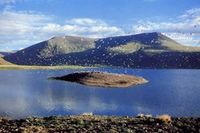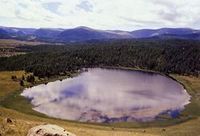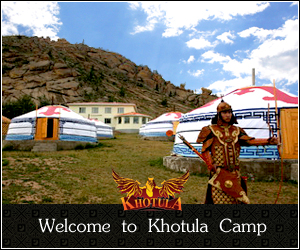Mongolian Lakes
 Lakes are one of the important geographical elements of Mongolia.
Lakes are one of the important geographical elements of Mongolia.
The mineral and chemical mixture of Mongolia’s lakes mainly depend on geological formation of surface and underground water and physical and geographical conditions of drainage areas.
The mineral and the chemical compound of lakes are determined by the lakes and salt balance, water exchange and outside low.
 Khuvsgul Lake
Khuvsgul Lake
Known as the “dark blue pearl” of Mongolia, Lake Khuvsgul is one of the largest and most spectacular protected areas of th country. Bordered to the north by the Sayan Mountains and to the west by Khoridal Saridag range, the lake is 136 km long and 3 km wide. This national park is comprised of the territories of Alag-Erdene, Renchinlkhumbe, Tsagaan Uul, Khankh and Chandmani-Ondor soums of Khuvsgul aimag. It has been purposed to represent taiga regional complexity, to protect the Khuvsgul lake basin, to develop eco-tourism, and to conduct surveys and studies in this field.
Sangiin Dalai Nuur
This large salt-water lake (166 sq. km) with a large bird population, is located on the south-western part of the aimag near the border with Zavkhan. The elevation here is about 2.000 metres above sea level. Southwest of the lake, in the Tes valley, is an attractive spot called Shavar Turuu.
Tsagaan Uur
East of Lake Kuvsgul is Tsagaan Uur sum, of interest primarily for the mysterious Dayan Derkhii cave. The cave is located at a site called Erdene Bulgan, on the east bank of the Tsagaan Uur River, 30 kilometres southeast of the sum center. The cave is ancient and well-known pilgrimage site where a deified shaman was venerated. According to legend, Dayan Delkhii was a shaman who was turned into a spirit of the surrounding stones and hills. His cult and not limited to Khuvsgul, but can be found throughout Mongolia among the Khalkha, Uriankhai and Buryats. Dayan Derkhii was considered the patron of shamanistic initiations, and Mongols used to come here from the south of the country to venerate him. The cave, 30 meters long, is one of the most impressive in Mongolia, with more than ten side galleries, dozens of openings, and a mineral spring.
Lake Tagan Nuur
This lake is located north of the sum center and about 50 kilometres from lake Khuvsgul. The village of Tsagaan Nuur, composed mainly of wooden houses, is located in what may he called the Lakes Region as it is here that some two-thirds of the 300 lakes of Khuvsgul province are to be found. The Dukha, or Tsaatan live in the surrounding mountains. Carvings about 50 kilometres from Murun is large rock called Bichigt Khad. The Rock carving of Khuukhdiin Ovoo are a group engravings on the left bank of the Tes River, about 10 kilometres west of the Tsetserleg soum center. They are thought to be between 2.000 and 5.000 years old.
Terkhiin Tsagaan Lake
Lake Khorgo is one of the country’s most spectacular places and is located in Taryat soum of Arkhangai aimag. The area comprising 77,267 hectares of land was designated as a national park. The spectacular mountain scenery and beautiful rock formations were formed by volcanic eruptions.
Ganga Nuur
The area surrounding the lake, which was formed as a result of sand block formed by wind movement, with a territory 32,860 hectares. It is a beautiful fresh water lake located between the mountainous steppe and Gobi regions. It composes the special local climate.
Khuisyn Naiman Lakes
The area covers 11,500 hectares around the lake located in the Uyanga soum territory of Ovorkhangai aimag to the southwest of the Khangai mountain range and its surrounding area. Khuisyn Naiman Nuur PA with its exceptional configuration is surrounded by the beautiful nature of the middle part of the Khangai mountain range. Also, it is a valuable monument for geological and water studies. These lakes with fresh water and interconnected by ground water channels such as Shireet, Khaliut, Bugat, Khaya, Khuis, Onon, Doroo, Bayan-Uul, are called Khuisyn Naiman Nuur (Khuisyn Eight Lakes).
Uvs Lake Basin
The range of ecological zones in the relatively small area of the Uvs Lake Basin is matched by few places in the world. From the perpetual snowfields and permafrost of the Turgen Mountains to the desert sands of Allan Els, the Uvs Nuur region encompasses 712,545 hectares of land. It consists of 4 parts: Uvs Lake part – located in the territory of Tes, Davst, Malchin, Naranbulag and Tarialan soums of Uvs aimag; Altan Els part – located in the territory of Baruun Turuun soum; Tsagaan Shuvuut part – located in Sagil soum territory; and Turgen Uul part – located in Turgen, Tarialan, Bokhmoron and Khovs soums territory.












